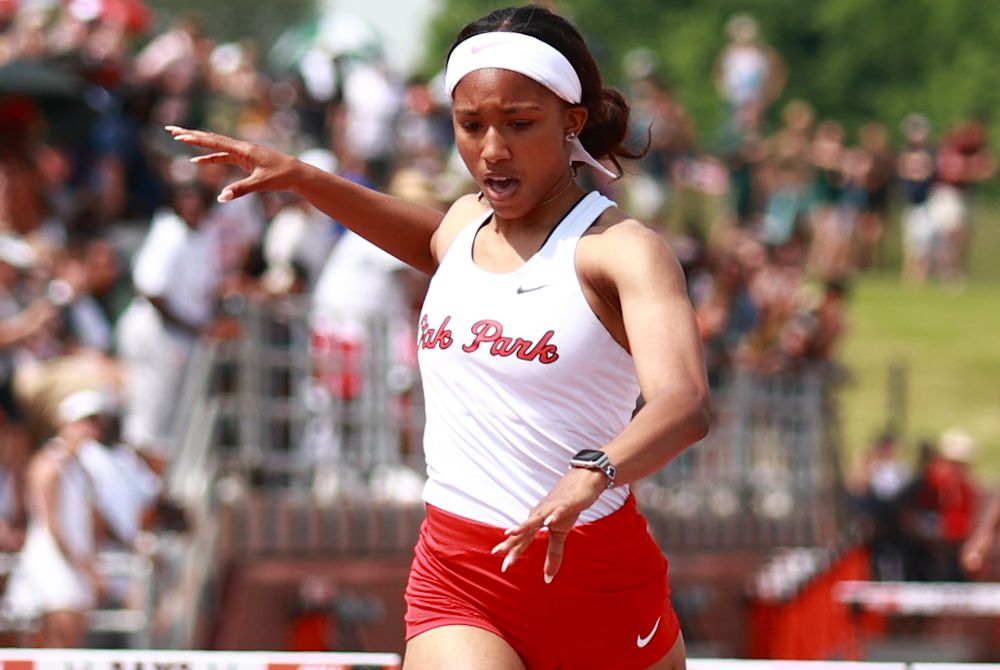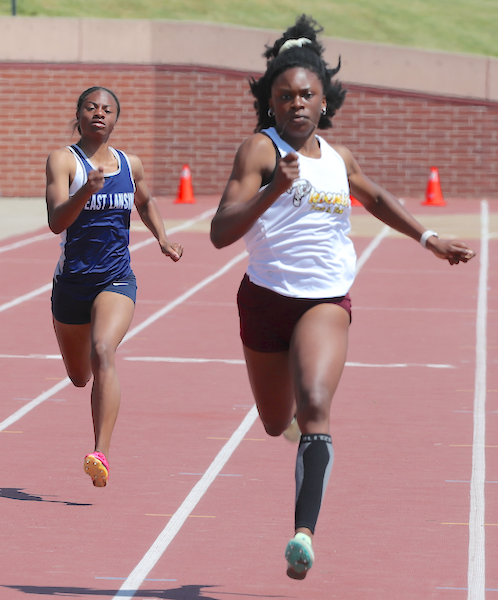
Track Gaining Speed Toward Future with Electronic Starting Devices
By
Steve Vedder
Special for MHSAA.com
May 23, 2023
Aubrey Greenfield thinks it might be the perfect time to reevaluate 130 years of tradition.
For a number of reasons, from technical to personal, the Oxford senior sprinter believes it makes sense for the crack of a starting pistol to be eliminated from high school track meets.
Because track meets would benefit in various ways from lowering costs to easier setup at meets to the human factor of competitors not having to flinch at the crack of a pistol shot, Greenfield believes the sport has a chance to embrace new technology – electronic starting devices (ESD).
In essence, an ESD replaces the starting pistol with a light flash, tone sound or both to begin a race.
"High school sports should put the athlete first," Greenfield said. "We should promote sports, and eliminating starting pistols promotes health in terms of PTSD or trauma for athletes and spectators and that would be good. I would like to think people would say that's a good idea."
In fact, Greenfield would go as far as to say if there was not an implementation of electronic starting devices, many of her teammates would have considered giving up the sport.
"If it's something that helps us compete safely, we're all for it," she said.
Greenfield's opinion apparently is spreading. Michigan High School Athletic Association senior assistant director Cody Inglis said the use of ESD makes it both affordable for meet starters and sensible for athletes and fans to rethink the use of starting pistols. While the MHSAA is not mandating electronic starting devices, it does promote the use of what Inglis calls "emerging technology." He notes that ESD are becoming the norm for organizations such as USA Track & Field, the NCAA and an increasing number of high schools.
 "I think we have to embrace new technology, and we think this will be something that takes hold," Inglis said.
"I think we have to embrace new technology, and we think this will be something that takes hold," Inglis said.
A key part of embracing ESD is the human element. The tragic Oxford High School shooting Nov. 30, 2021, that took the lives of four students while injuring seven others should not be relived even for a fleeting instance at a high school sporting event. Oxford athletic director Tony DeMare said the school began using ESD at every meet, including the MHSAA Lower Peninsula Division 1 Finals last June. He said that decision was embraced by virtually all schools Oxford encountered.
"We were very convinced that the alternative (of ESD) would promote a healthy attitude," DeMare said. "We were overwhelmed with the positive response. If a school was on the fence about it or might not be for it, I think we've started to see the tide turn in favor of people willing to listen and learn about electronic starting devices."
Inglis said the MHSAA is acutely aware of what the crack of a starting pistol can mean to athletes and fans.
"It's unimaginable what Oxford went through, and this is a small way we can help," he said. "We look at a (starting pistol) and think, ‘Could we do something else?’ It's a way of helping to solve a problem."
Over the last several years, the MHSAA has embraced finding an alternative to starting pistols. Inglis noted the discussion started with the cost and diminishing availability of 32-caliber ammunition that meet starters use. A box of ammunition, if it can be found, is around $75 a box.
In addition to cost, there is potential damage from excessive exposure to 150-plus decibels of sound generated by the traditional 32-caliber blanks. Medical studies show damage to ears caused by decibel levels above 120 dB.
The tragedy at Oxford accelerated the conversation.
Inglis said the cost of ESD can be likened to a school sinking money into artificial surfaces at football fields. Yes, there is a great cost at first, but over time money is ultimately saved. An ESD system itself ranges between $200 and $500. Speakers also may need to be purchased, but with ESD starting events like the 800 and 1,600-meter relays positioned near the outside lanes 8, 7, 6 and 5 would result in improved hearing by athletes at the start of a race.
There is one challenge with ESD that track administrators are working to overcome – lighting conditions that lessen the ability to see the ESD’s LED light or strobe when the button is pressed by a starter to begin a race. But that vision difficulty resulting from clear blue skies and backgrounds of setting suns can be substantially improved by incorporating a black background with an ESD – something as simple as a starter holding up black cardboard behind the lighting mechanism at the start of an event.
Inglis said when all factors are considered, the use of ESD makes sense.
 "With the climate we live in nowadays, no lookalike guns is good," he said. "We're not mandating this. But people are saying this is affordable."
"With the climate we live in nowadays, no lookalike guns is good," he said. "We're not mandating this. But people are saying this is affordable."
While switching to ESD would break 130 years of tradition, the timing could be a step forward, said Jeff Hollobaugh, co-author of the book "The Fleet Feet of Spring: Michigan's High School State Championships in Track & Field." He said while no definitive answer is possible, it's likely starting pistols were used at the inaugural state meet at the Jackson Fairgounds in 1895. The meet, which included events like tossing a 16-pound shot put, bike races and a 100-meter sprint, was sponsored by the Michigan Interscholastic Athletic Association (a predecessor to the MHSAA) and comprised mostly of the state's larger schools.
Hollobaugh's sentiments echo what many involved in today's high school track & field believe in terms of making a transition from starting pistols to electronic starting devices.
"It's a change, not necessarily good or bad, just different," he said. "It's not a drastic change, but it will take some getting used to. But it is the future. In the end, we'll all be fine."
DeMare believes the future of high school track will definitely include ESD.
"Our desire is that the practicality and sensibility of this will overcome the alternative," he said. "I think we'll see the automation and electronics taking hold of certain elements in track, and people will embrace it."
PHOTOS (Top) Runners watch official Bertha Smiley as they prepare to begin a race during last season's Lower Peninsula Division 1 Finals at Rockford. (Middle) An electronic starting device provided by VS Athletics was used to start those races. (Below) Smiley sets to begin an event. (Photos provided by David Kuderka/VS Athletics.)

Oak Park Girls Hurdle Competition Again to Regain LPD1 Championship
By
Keith Dunlap
Special for MHSAA.com
June 3, 2023
ROCKFORD – For the fourth time in five seasons Saturday, Oak Park’s girls captured the Lower Peninsula Division 1 team title – this time with a meet-best 80 points at Rockford High School.
Last season’s champion Detroit Renaissance was second with 58 points, while Ann Arbor Pioneer was third at 56.
The Knights – runners-up a year ago – won again mainly thanks to their dominance in the hurdles. Senior Nonah Waldron won the 100 and 300 hurdles, but also Morgan Roundtree was third in the 100 (13.86) and second in the 300 (41.54) and Carrie VanNoy was fourth in both the 100 (14.18) and 300 (44.11).
Waldon said the team’s success was all about pushing each other the best they could in practice every day.
“It takes maturity to understand that you all can be great together,” Waldron said. “It took a lot of love for each other to be the best we can be.”
 The Knights also were second in the 400 relay (47.71) and 800 relay (1:38.21), and third in the 1,600 relay (3:55.27).
The Knights also were second in the 400 relay (47.71) and 800 relay (1:38.21), and third in the 1,600 relay (3:55.27).
“I think that dealing with losing and some adversity helps you grow,” Oak Park coach Brandon Jiles said. “I think the kids used the experience from last year to catapult them this year. We know it’s a points game. We know there are no style points in team championships. We spread the kids out to do what we needed to do. We’re not a depth team, but a quality team. They showed out, and I’m happy.”
Waldron won the 100 hurdles in a time of 13.56 before really putting on a show in the 300 hurdles. She won that event in a time of 40.37, which was the second-fast time in that event in the nation thus far this year. Waldron, who will run in college at USC, also won both hurdles events two years ago and won the 100 hurdles last year, but had a mishap that cost her last year’s title in the 300.
“Last year, I fell and tore my ankle,” she said. “That did motivate (me) a lot more than before. It made me want it more.”
If it wasn’t evident that Renaissance sophomore Jayla Dace might be the state’s next big sprinting star already, she established that on the biggest stage.
Dace won the 100-meter dash in a time of 11.90 and was a part of winning 400 and 800 relay teams. Dace also took third in the 200-meter dash in a time of 24.56.
“The starting gun is a horn, so I’m not really used to that,” Dace said of her strategy in the 100. “I had to really adapt quickly and to make sure I wasn’t the last person to get out of the blocks. Once you see people in the 100 ahead of you, it’s over. I just had to make sure when I started the race that I really didn’t see anybody.”
In the relays, Dace ran the second leg in the 400 and the first leg in the 800.
 “I’m just happy we were able to execute,” Dace said.
“I’m just happy we were able to execute,” Dace said.
Saturday was quite an inauguration into the pressure of a high school state meet for West Bloomfield freshman Kamryn Tatum. But she performed like a veteran, winning the 400 in a time of 55.74 and the 200 in a time of 24.10.
“I’ve been at big meets so I know how to deal with quite a bit of pressure, but I was still nervous because it was my first high school (Finals),” Tatum said. “I just wanted to run until the end of the line.”
Ann Arbor Pioneer junior Rachel Forsyth won the 800 (2:09.96) and 1,600 (4:44.22), and East Lansing senior Anna Delgado finished first in the 3,200 (10:33.87). Forsyth also was part of Pioneer’s winning 3,200 relay (9:01.19), and Detroit Cass Tech won the 1,600 relay (3:52.82) by 12 hundredths of a second ahead of Renaissance.
Howell senior Sophie Daugard was first in shot put (41-7), Allen Park junior Abigail Russell first in discus (148-7½), and Grand Rapids Forest Hills Central junior Brooke Bowers won pole vault (12-3). Farmington Hills Mercy junior Milena Chevallier won high jump (5-11), and Rockford senior Maya Anderson was champion in the long jump (18-6½). Flushing sophomore Ally Ingrahm competed in the adaptive 100 (42.81).
PHOTOS (Top) Oak Park's Nonah Waldron crosses the finish line first in the 100 hurdles Saturday. (Middle) Renaissance's Jayla Dace, right, charges toward the finish. (Below) West Bloomfield's Kamryn Tatum, far left, leads the 200. (Photos by Jamie McNinch [top photo] and Carter Sherline/RunMichigan.com.)

